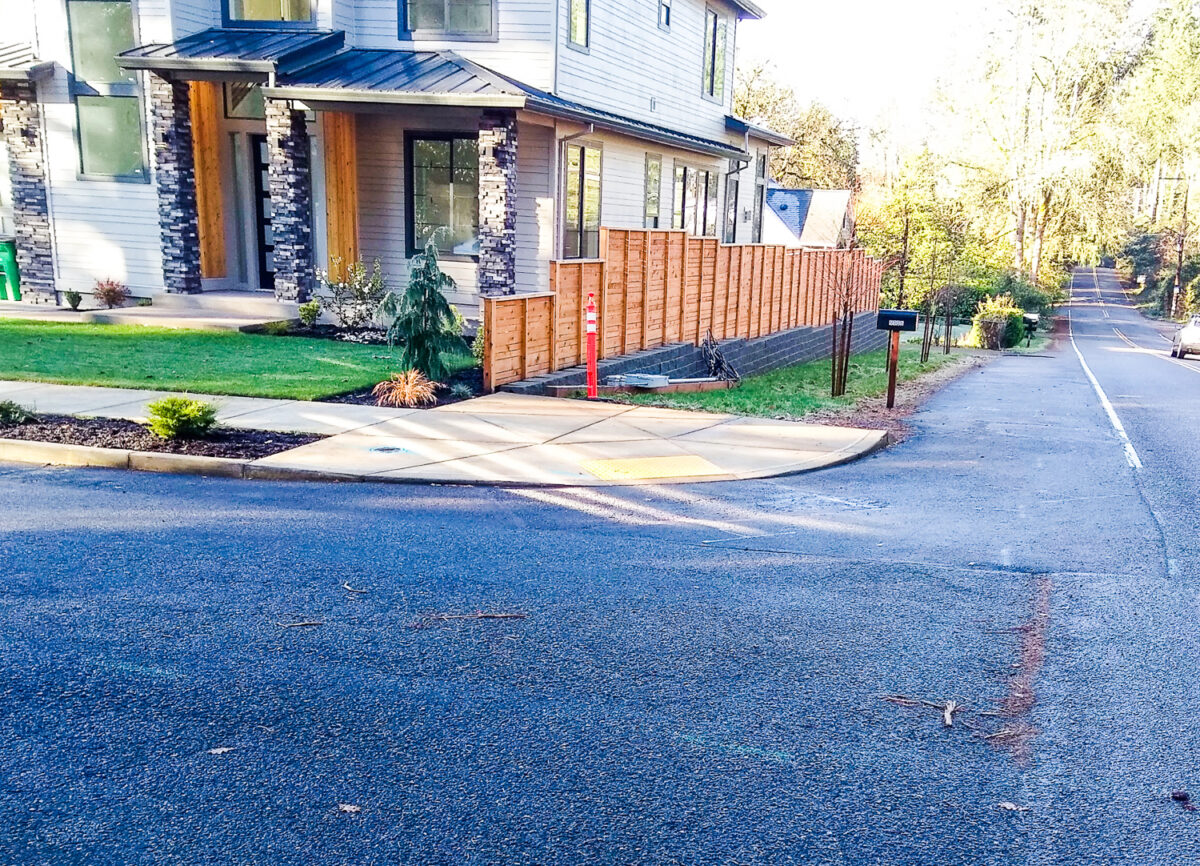
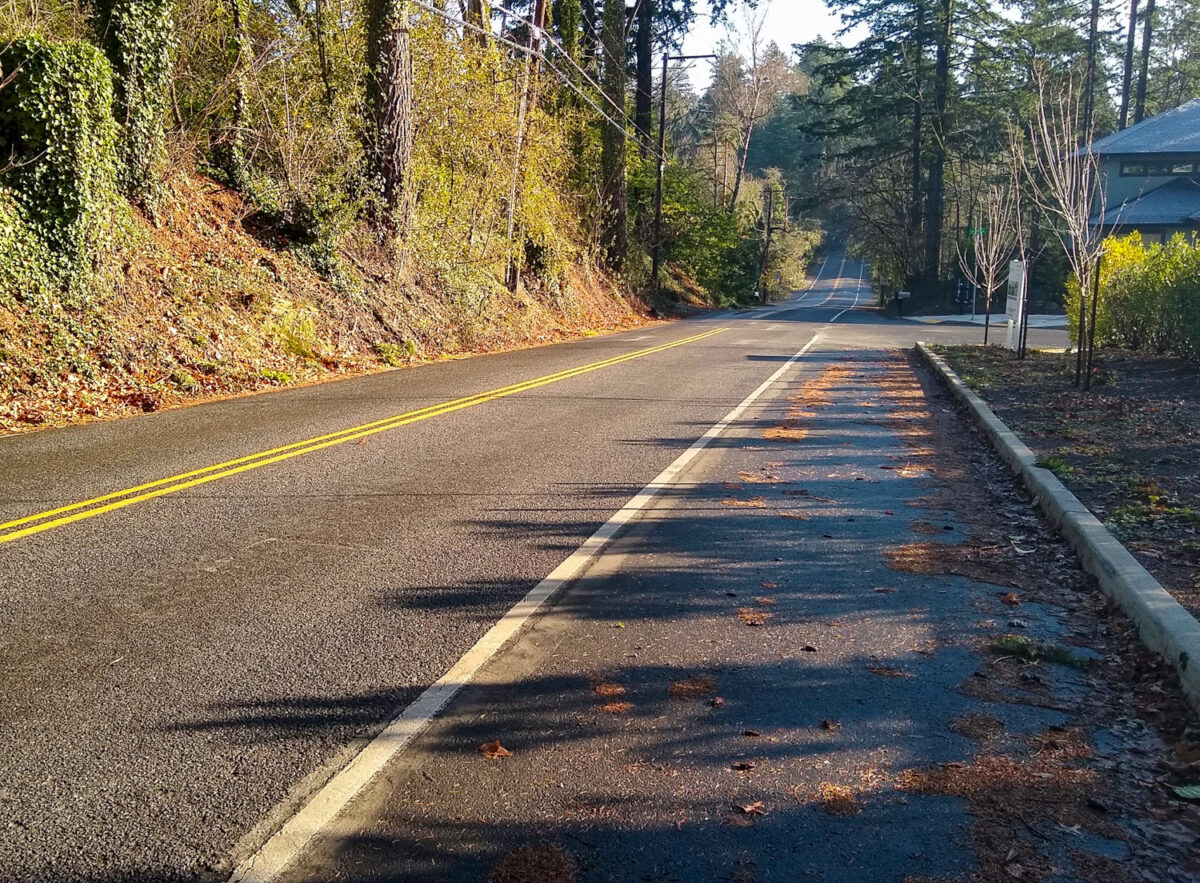
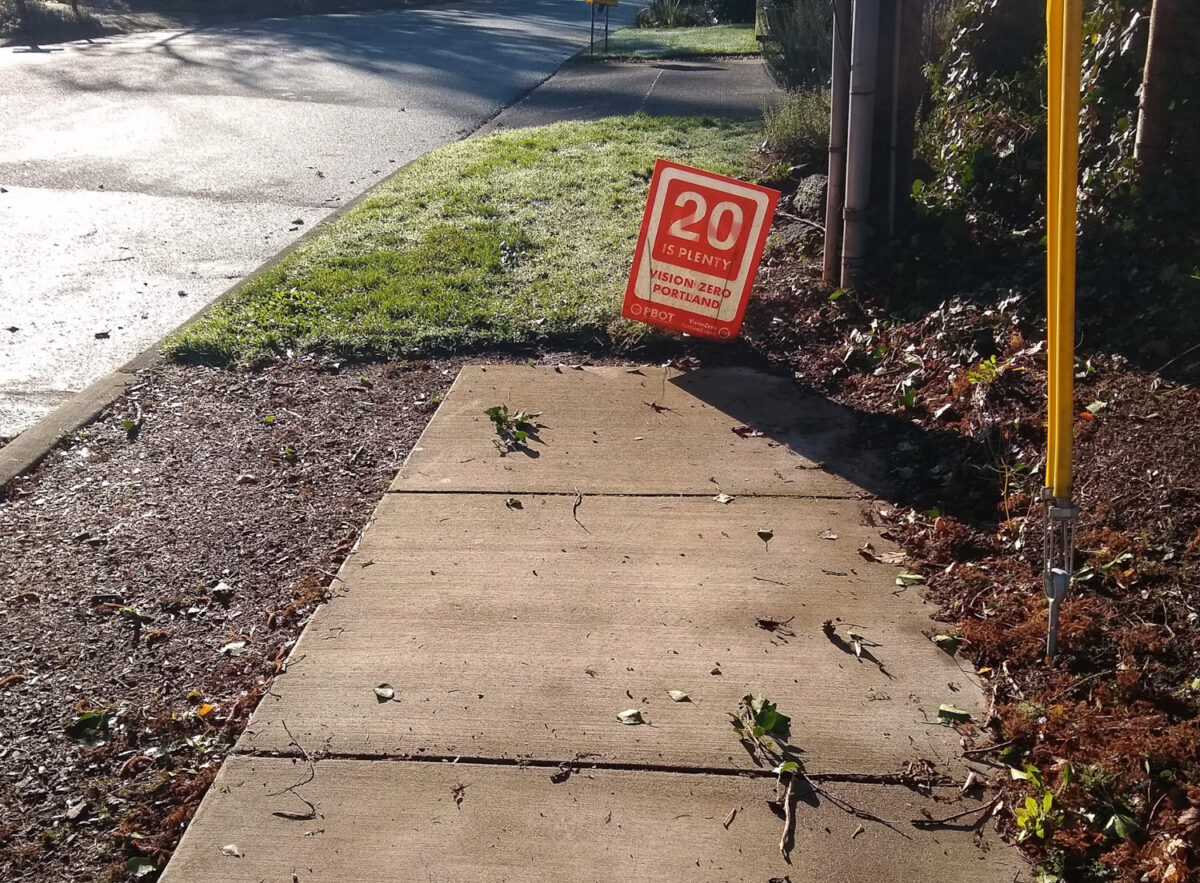
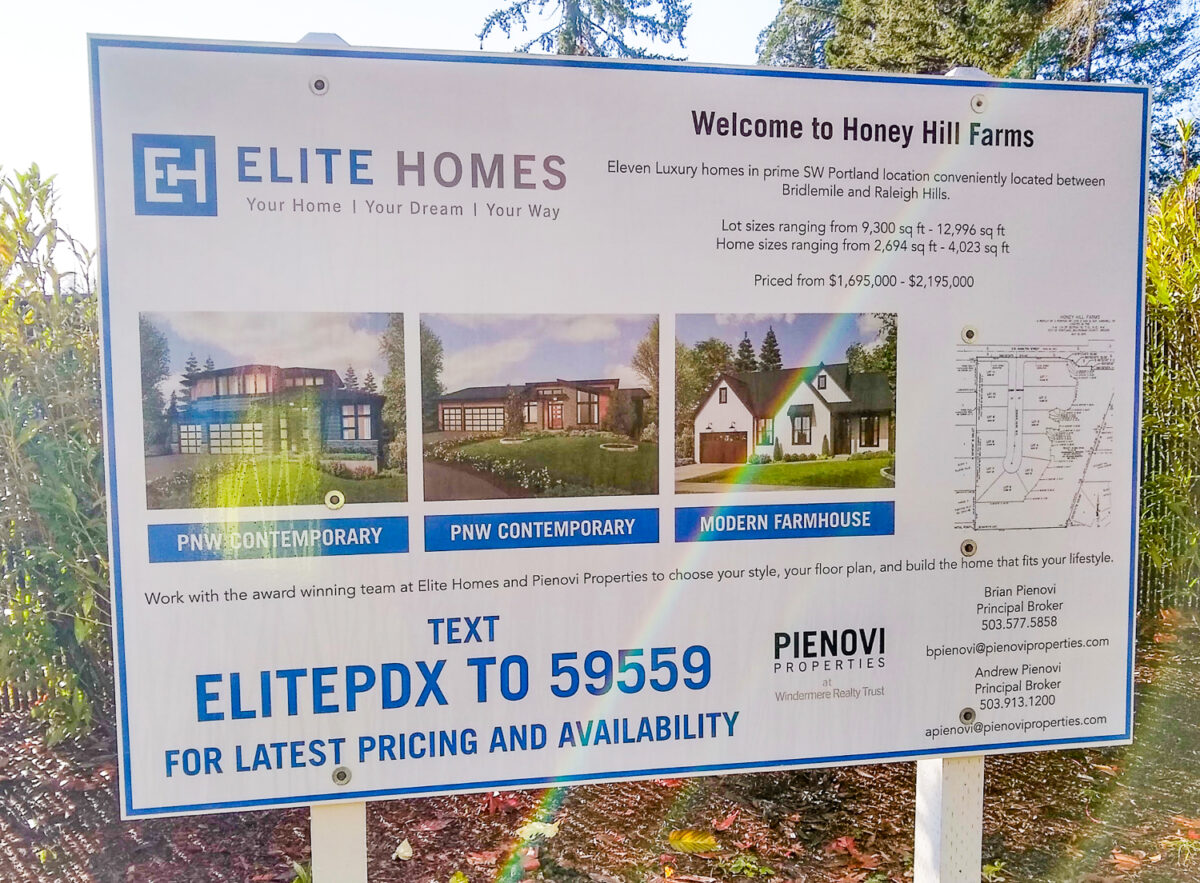
[Publisher’s note: This will be David’s final article for BikePortland. Since he’s currently chair of the PBOT Bicycle Advisory Committee, the City of Portland said he would have to step down from that role if he wanted to write for us. He chose to continue being chair of the BAC. Thanks for sharing your insights David! And thanks for being a volunteer advocate on that important committee. – Jonathan]
If you’re wondering why it was necessary to require a 10-ft wide sidewalk on a local-access street while the local collector with a bus stop would be “adequately” served by a four-foot asphalt shoulder, all I can say is that’s a really good question.
This is the final piece of a three-part series on how SW Hamilton Street illustrates the many challenges to creating safe walking and biking facilities in southwest Portland. In the first part I gave some context for SW Hamilton, then in part two I shared an example of a typical City of Portland project on the street. While city projects have had an impact, redevelopment by private entities has presented an even more confounding situation.
Before we get any further, I want to add a couple of notes. I was Chair of Bridlemile Neighborhood Association (BNA) from May 2016 to May 2018 and served on the Board of Directors for a bit over four years in total. All of the projects in prior years garnered many opinions from board members and neighbors, some stronger than others. In this series I’ve leaned on public records documenting the decisions made along with what is on-the-ground today. Plans and other information that were not explicitly public were acquired and shared through third-parties who are also deeply invested in this neighborhood and its infrastructure.
It also needs to be said that there are many competing priorities throughout the city and expecting world-class facilities on every road is not reasonable with the transportation bureau’s $4 billion maintenance backlog. But when a property is developed, we often have a blank slate and a new pool of funds to provide something better just by adhering to existing policies that obligate developers to specific responsibilities. As you will read, the result if often a newer version of what’s already there, rather than holding a developer to a higher standard on behalf of the new residents that will eventually live on the property.
Advertisement
Lack of Sidewalks
Precedents are funny things. Sometimes they are set after community input and careful consideration, other times it’s an afterthought. The lack of sidewalks on Hamilton can be traced to two projects that exemplify the power of precedent.
The lack of sidewalks on Hamilton can be traced to two projects that exemplify the power of precedent.
You’ve already read about the first precedent, a bioswale project completed by the Portland Bureau of Environmental Services in 2016. They were able to extend the shoulders as part of the project because it was inexpensive and the stormwater mitigation that drove the project did not have to be expanded by keeping the right-of-way to only asphalt. The project left much to be desired by the neighborhood, they even wrote a letter that outlined their dissatisfaction. Now that ongoing maintenance has ended, the bioswales are overrun by invasive blackberries and foliage partially blocks the shoulder. Roads that have no curb are considered self-cleaning — meaning getting any kind of brush clearing is near impossible (that’s a story for another day).
The second precedent happened when the City of Portland enabled developers to build several million dollar homes while minimizing frontage improvements through a slick-land use maneuver. Back in 2016 a developer wanted to shift lot lines around to allow them to build four houses where two creeks meet amid Environmental Protection and Conservation overlay zones. These overlays are quite common in southwest Portland and are supposed to provide an extra layer of protection for sensitive areas. The lots were at the northeast corner of Hamilton and 58th Avenue, but the addresses all listed 58th Avenue rather than Hamilton St.
As a result of the address being on 58th Avenue rather than Hamilton, the frontage requirements were minimal. The initial decision by the city was that a sidewalk would be required on both sides of 58th and there would be no improvements on Hamilton. After appealing that decision, 58th was allowed to stay in its existing state with no improvements or even repaving. When the full environmental review decision was released all of this was already baked-in. Due to this being a land-use decision regarding environmental overlays and not development, the Bridlemile Neighborhood Association (BNA) was advised by city staff that appealing street improvements would be unsuccessful. As promised, BNA filed a detailed appeal which included disapproval of the frontage requirements that the city had approved and as expected the end result was in line with the developer’s request.
In the final decision Hamilton was described as “improved with a 22-foot-wide right of way, also without curbs or sidewalks.” It continues “[a] Public Works Alternative was approved by the Public Works Alternative Review Committee, which determined that standard frontage improvements would not be required along either SW Hamilton or SW 58th in relation to the construction of the four single-dwelling residences proposed for this site.”
There’s a lot to dissect within that last paragraph. SW 58th is one of many roads in southwest without curbs, sidewalks, or shoulders and this decision meant the status-quo would be maintained. Hamilton didn’t require any improvements either, however the developer agreed to PBOT’s request to extend the shoulder on the north side of the street. A final note is that the following statement also made it into the appeal “although frontage improvements along SW Hamilton and SW 58th will not be required at this time, they will be required in the future.” It is not clear if there is an enforceable mechanism to make this happen nor is there a timeline for this future requirement.
Advertisement
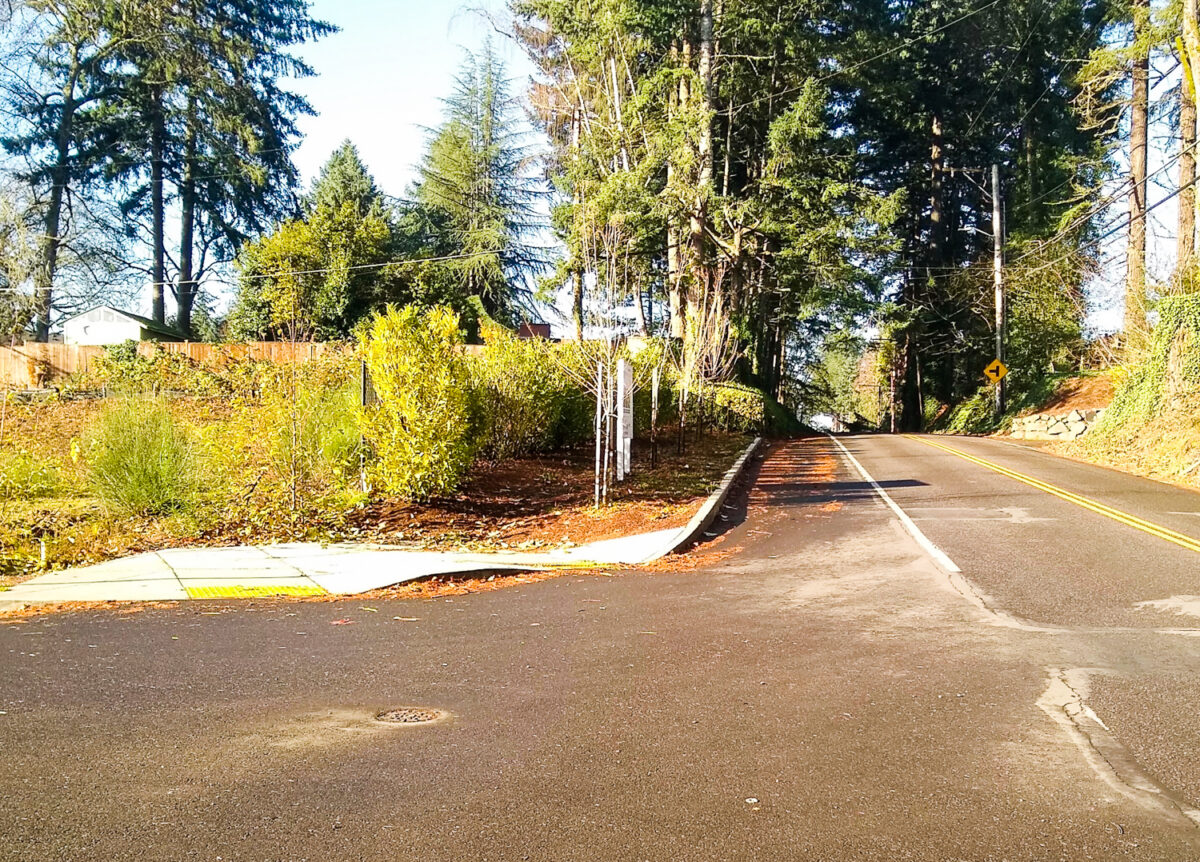

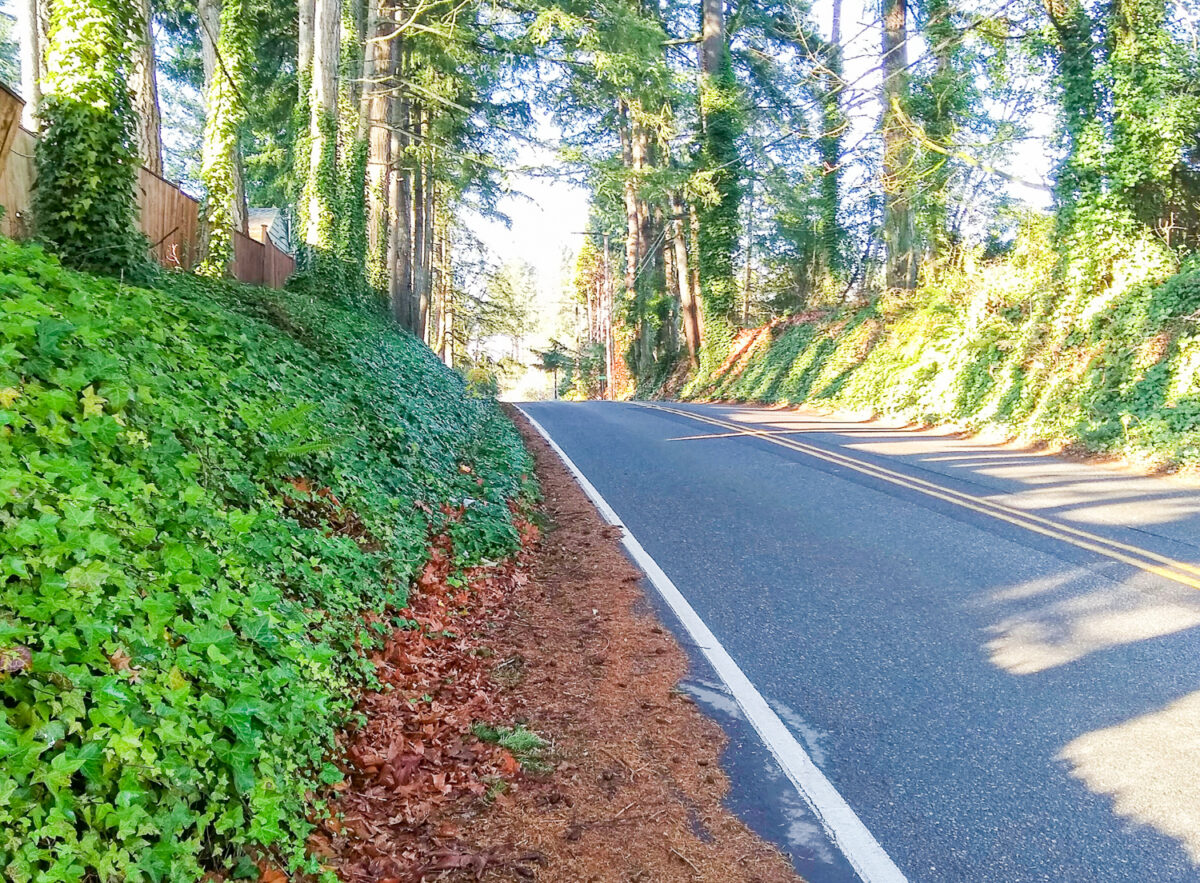
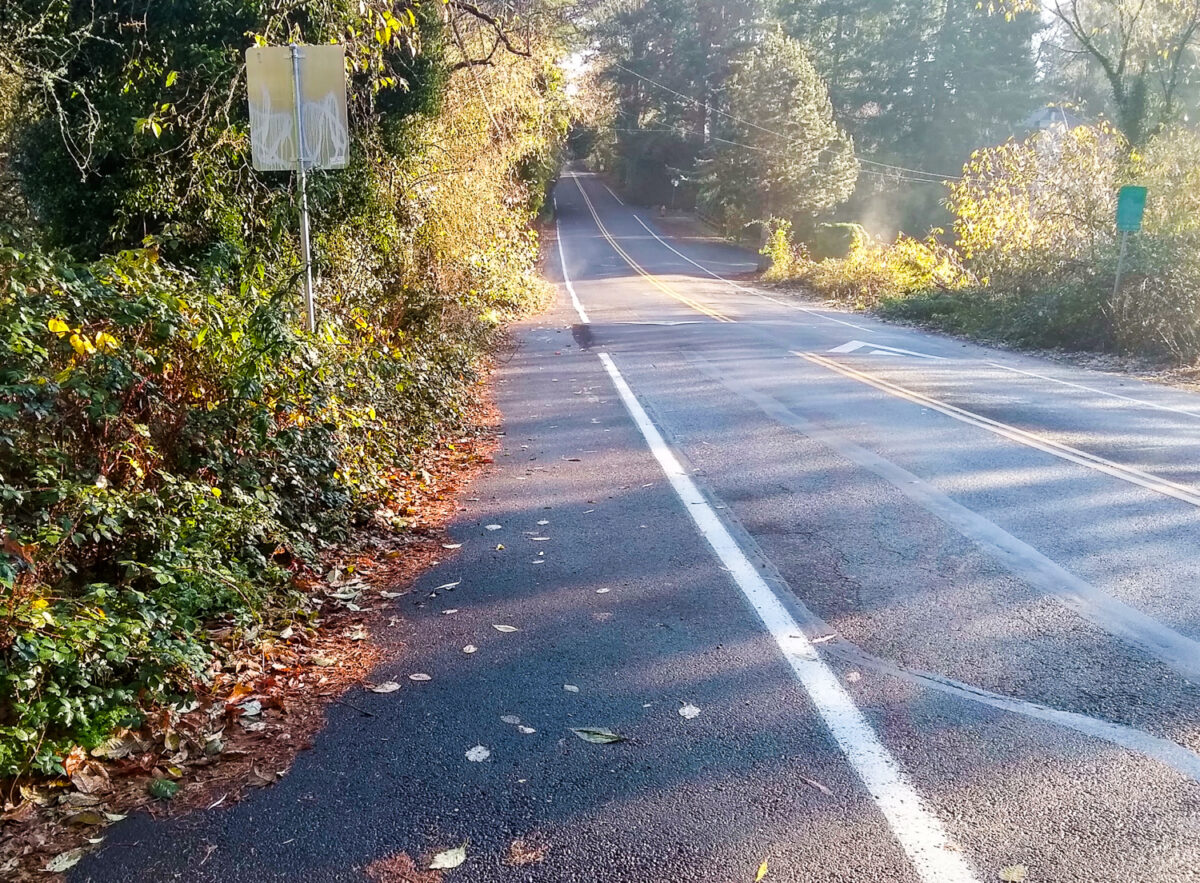
Subdivisions Arrive
Less than two years later, the house across the street, on a lot with over four acres of land, was ready to be replaced with a subdivision. While sidewalks would be installed inside the new development, only extended shoulders were necessary for Hamilton. While BNA had a stated desire to include sidewalks it quickly became clear this was not going to happen and the focus instead shifted in a new direction: contiguity.
BNA wanted the shoulders constructed at 58th Ave to connect with the ones that would be installed at the to-be-constructed 59th Ave. This would provide multiple blocks of continuous, connected shoulder space for people to walk, run, or bike (uphill) without having to cross the street which was signed at 30 mph at the time. Unfortunately, this proposal was scuttled by two forces; a property owner that didn’t want the shoulder on their side of the road and the city not being able to do anything to force the issue as it was outside the project scope.
This development is currently being constructed with houses being listed around $2 million each. The sidewalks that are present look nice and the curb ramps are already installed which will make it easier for people to access the neighborhood when they park in the shoulder. A feature of these shoulders is that not only can they facilitate people walking and on bicycles for short distances but there is no signage prohibiting parking so they are truly all-access. This hasn’t led to much conflict yet since only one or two of the houses appears to be occupied. But this could change in the coming years.
Moving on to the final development on our tour, 2018 was a busy year and a simpler land use decision next to Hamilton was also moving forward at 53rd Ave. A house had been removed from a larger lot and the request was to divide the lot into two parcels. No environmental overlays were present and 53rd already had curbs. As a result the improvements were as follows:
“Consistent with the Public Works Alternative approved for this site (17-270729-PW) required improvements within SW Hamilton will include: widening of the roadway shoulder by extending the existing paved roadway to provide a 4-ft asphalt shoulder; dedicate 14-ft of property for ROW purposes; and adequate conveyance of stormwater, if necessary as determined by BES, along the property frontage. Required improvements on SW 53rd will include construction of the 10-ft wide sidewalk corridor behind the existing curb.”
If you’re wondering why it was necessary to require a 10-foot wide sidewalk on a local-access street while the local collector with a bus stop would be “adequately” served by a four-foot asphalt shoulder, all I can say is that’s a really good question.
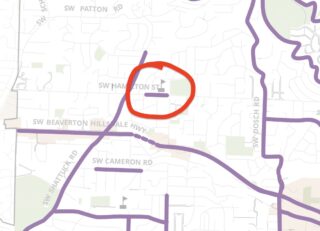
I get a bittersweet feeling when I look back on these developments, the projects by BES and PBOT, and all the gaps that remain. I was part of fighting the good fight, seemingly losing at every turn to the whim of budget or policy decisions. Still, conditions have improved from their prior state and if the Southwest in Motion project on Hamilton (BP-43, which calls for a new sidewalk from 48th to 45th outside Bridlemile Elementary School) is actually implemented there might even be a new sidewalk to make that last connection to school a little less stressful. New development will continue as well, it’s too lucrative for property owners to ignore forever. And while it may take decades to happen, eventually the gaps will become small enough that it will become more feasible to fill them in.
I hope you enjoyed this series! It gives you just a little window into what it takes to be an advocate for better streets in southwest Portland. Sort of like riding a bike, the climbs are tough, but when you get to the top it’s well worth it.
For more about why there are so few sidewalks in southwest (and east) Portland, see this previous article by Lisa Caballero: Sidewalks and Portland, it’s not so simple.

